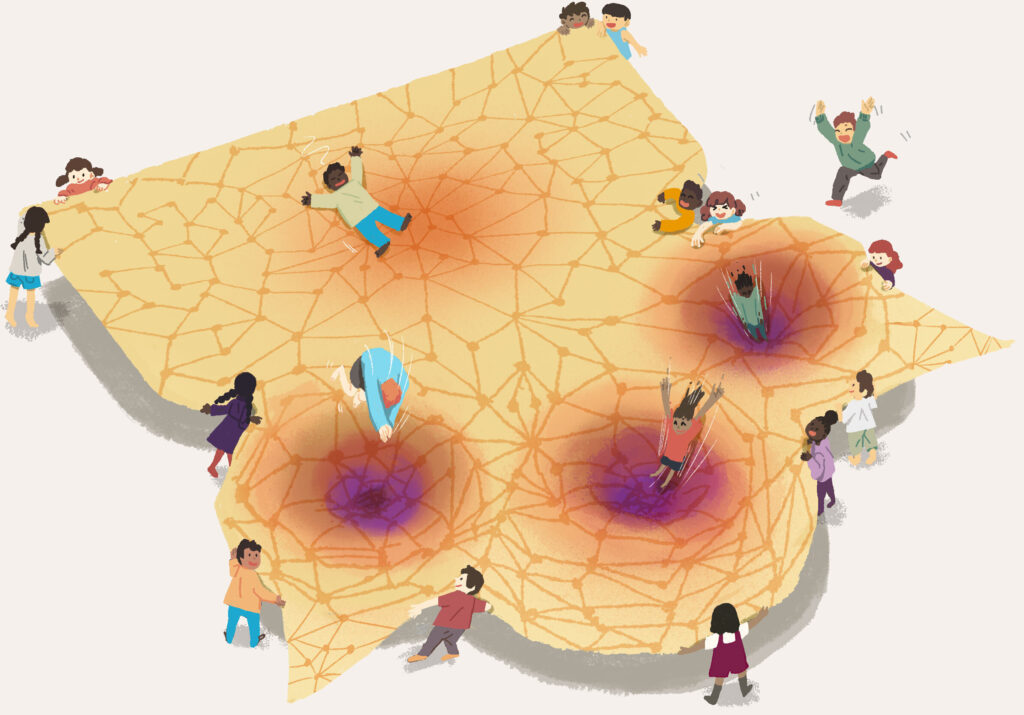Paper Co-Authered by Araya Chief Researcher Pablo Morales to be Published in “Nature Communications”
On July 24, 2025, the paper titled “Explosive neural networks via higher-order interactions in curved statistical manifolds” (DOI: https://doi.org/10.1038/s41467-025-61475-w) co-authored by Dr. Pablo Morales, Chief Researcher of the Information Theory & Complex Systems Team, Research and Development Department, Araya Inc.; Dr. Miguel Aguilera, Researcher of the Basque Center for Applied Mathematics in Spain; Dr. Fernando E. Rosas, Lecturer of the University of Sussex in the UK; and Dr. Hideaki Shimazaki, Associate Professor of the Graduate School of Information Science, Kyoto University will be published online in the British international scientific journal “Nature Communications.”

Children playing on a curved neural network, representing explosive memory recall. (Illustration by Robin Hoshino)
This study applies theories from statistical physics to reproduce the “explosive” sudden state changes observed when networks recall memories, as well as the resulting improvement in memory capacity. This is an important achievement that contributes to a fundamental understanding of the information processing mechanisms of the brain and the development of more advanced artificial intelligence (AI).
In information processing systems such as our brains and AI, it is believed that complex “higher-order interactions (HOIs)” involving three or more elements influencing each other simultaneously play an important role, rather than simple one-to-one relationships between numerous neurons (nerve cells). However, accurately and simply describing these higher-order interactions using mathematical models has been a difficult challenge.
Based on the concept of information geometry, we proposed a new approach called the “maximum entropy principle on curved statistical manifolds” and constructed a model that naturally incorporates higher-order interactions while keeping the number of parameters to a minimum.
This model has the following main features.
1. Explosive phase transitions and hysteresis:
When the network recalls memories in response to external input, it exhibits extremely rapid and discontinuous state changes (explosive phase transitions). This dynamics is accompanied by “hysteresis,” a phenomenon in which once the state changes, it is difficult to return to its original state, resembling the complex behavior observed in real brain activity.
2. Improved memory capacity and retrieval ability:
To evaluate the performance of the associative memory model, we analyzed it using the “replica method” and theoretically demonstrated that the model can store more information (increased memory capacity) and retrieve memories more stably than conventional network models. This performance improvement suggests that the explosive dynamics enhance the memory retrieval process.
These results provide a new approach to explaining the fundamental higher-order interactions in information processing in the brain using a unified and simple mathematical framework. Further development of this model is expected to lead to a deeper understanding of brain function and the design of next-generation AI with high performance at lower computational cost.
Comments from the Researcher(Pablo A. Morales)
This study provides a groundbreaking perspective for the exploration of higher-order interactions (HOIs) in complex systems. It applies the generalized maximum entropy principle to capture the essence of HOIs without needing a vast number of parameters. This breakthrough represents a major advancement, as it allows for the investigation of previously intractable system behaviors, such as explosive phase transitions and multistability. Furthermore, the fact that these complex behaviors are not externally imposed but arise from the very structure of memory is particularly noteworthy.
Related Links
Pablo Morales – Google Scholar

 受託開発・お問い合わせ
受託開発・お問い合わせ